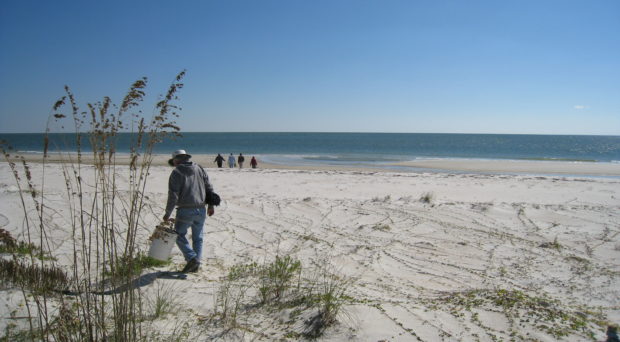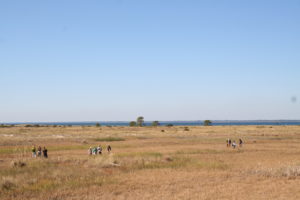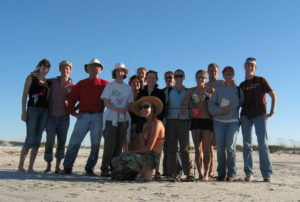
Why I am fascinated by barrier islands
I grew up in the arid southwestern United States, far from the ocean. When I moved to Florida, I quickly learned to love barrier islands, which I found to be both exotic and beautiful. I was working on St. George Island in the northern Gulf of Mexico in the late 1990’s with a postdoc, Gretchen LeBuhn, and we were both struck by the similarities between the islands and, oddly, southwestern deserts. Plants from both islands and deserts are subject to very harsh conditions and affected by extremes in precipitation and temperature, with windblown and low-nutrient sandy soils.
Understanding barrier islands is very important for the ecology, conservation, and economy of coastal areas.
Further, the vegetation dynamics were similar, in that species abundances could change quickly and dramatically. Species could appear or disappear in different years or locations. What made islands unique from deserts were tropical storms; I had two entire field season’s wiped out by tropical storms and was witness to the significant destruction on St. George Island by Hurricane Opal in 1995.
Studying barrier islands
Gretchen and I were fascinated by the “shifting mosaic” of different species changing in occurrence in different parts of the dunes across months and years. We thought about how to quantify these spatial and temporal patterns and concluded that a long-term study on the fairly large scale of dunes and troughs was required. We devised replicate large plots using a simple grid system within each plot and were about to start our first census in 1998 when Hurricane Georges brought 3 m of storm surge and destroyed some of our plots. I re-established the plots in 1999 and we have sampled the plots annually ever since.

I must admit that our initial goal was to just satisfy our own curiosities, and that Gretchen and I didn’t know about the larger potential value of this research. Barrier islands occur along many coastlines worldwide in areas prone to high disturbance from storms. Their coastal dunes protect inland areas, including both human habitation and natural resources such as seagrass, oyster beds, and salt marshes, all of which serve as nurseries for important fisheries. Understanding barrier islands is very important for the ecology, conservation, and economy of coastal areas.
Their coastal dunes protect inland areas, including both human habitation and natural resources such as seagrass, oyster beds, and salt marshes, all of which serve as nurseries for important fisheries.
Sand dune communities have also been used in many classic studies in ecology, going back to Cowles work in the 1890s on succession. In ecosystem ecology, barrier islands are interesting because of a dynamic tension between the shapes and positions of the dunes and the vegetation growing on them. The dune structure determines what plants will establish and grow, while the vegetation can control the stability and dynamics of the dunes; meanwhile, both dunes and the vegetation undergo succession as islands build.
The importance of long-term studies
Our paper in Plant Ecology with the first eight years of the census was important for documenting effects of hurricanes, while also showing that other, less obvious climate factors such as drought could have equally large effects. Elise Gornish and Hannah Buckley helped develop the analyses, using some interesting approaches for using long-term ordination data that we took from a paper by Tadashi Fukami. Gornish later went on to use the long-term data as the basis for a model of hurricane effects on barrier islands, as well as to develop methods for restoration of dunes following hurricane disturbances.
One reason why this study has been well cited is the dearth of similar long-term studies of sand dunes, especially in the Gulf of Mexico. The data provided by long-term studies are absolutely necessary for understanding natural dynamics, as well as for understanding the effects of sudden (e.g. oil spill, hurricane) and more gradual (e.g., sea level rise) disturbances. Long-term studies are easy to initiate, hard to maintain, and often require significant investment of time and energy before they provide any meaningful results. Yet, long-term studies fill an important need and I encourage everyone to consider initiating or participating in such studies.
The best science is done with friends

Other than working at a beautiful site, one of the real pleasures I have derived from this study is gathering colleagues, friends, and students together each year to conduct the survey. It takes more than 10 people to complete the census over two or three days each fall. Now, by 2016, this research program has contributed to eight publications, two Master’s Theses, and many undergraduate research projects, and is a component of a field course for our entering graduate students in Ecology and Evolution at Florida State University. Certain people have been critical for keeping this project going, including Elise Gornish, Abigail Pastore, Marina Lauck, and especially Alice Winn. The annual census always reminds me of the companionship and joie de vivre that attracted me to ecology in the first place.
Read full article: Climate and coastal dune vegetation: disturbance, recovery, and succession
Thomas Miller
Latest posts by Thomas Miller (see all)
- Climate and coastal dune vegetation - 21st November 2016